Best laptops for photo editing 2023: Best overall, most portable, and more


Whether you’re capturing those special moments at a wedding or carefully positioning a sleeping newborn for the most precious picture, professional photography takes some serious skill. But taking beautiful photos is only half of the job. Editing those photos can take hours and if you don’t have the proper workstation for it, you’re screwed.
That’s where the team at PCWorld swoops in. You’re going to need a laptop with a powerful CPU for those power hungry editing programs, discrete graphics, and a high-resolution display. You’ll also need to take storage and portability into consideration. If you’re not sure where to begin, don’t sweat it. We’ve curated a list of the best laptops for photo editing available today. Read on to learn more.
[Looking for something else? Check out our best laptop roundup for more options]
Updated 5/31/2023: We updated this roundup to add the Asus ROG Strix G18, the Asus Zenbook S 13 OLED, the Lenovo Slim Pro 7, the Samsung Galaxy Book3 Ultra, and the Apple MacBook Pro 2023 to our recommendations. Read on to learn more about our top picks.
Asus VivoBook Pro 16X OLED – Best overall
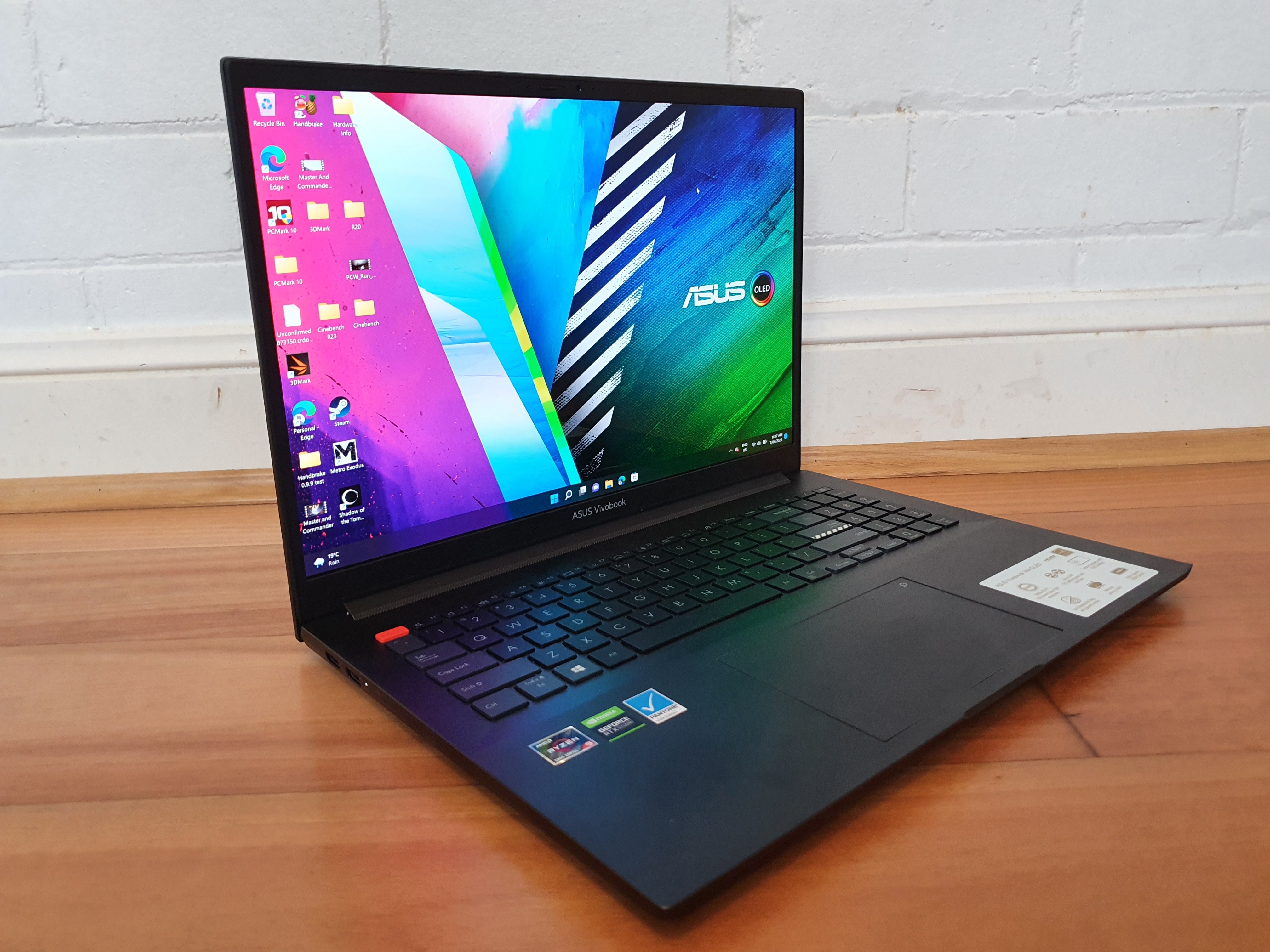
Pros
Beautiful 4K OLED display Long battery life Useful DialPad tool
Cons
Design lacks flair Lackluster webcam Price When Reviewed:$1,599.99Best Prices Today:$1449 at Asus
If you’re looking for a killer display, the Asus VivoBook Pro 16X OLED is a fantastic choice. The 4K OLED panel is a work of art. Not only does it produce vibrant images, but it’s a solid choice for those who deal with tension headaches from eye strain. If you find yourself spending hours upon hours looking at a screen, you might as well invest in one with a sharp picture. The VivoBook is also powerful when it comes to processing power. Let’s take a look under the hood, shall we?
The Ryzen 9 5900HX CPU is fast enough for photo editing software like Adobe Lightroom and Bridge. As for memory and storage options, it has 32GB of RAM and a whopping 1TB of PCIe NVMe M.2 SSD storage. That’s sufficient for quickly firing up multiple applications and storing gigantic RAW images. There are a few flaws to be aware of, though. The webcam is less than stellar and the fingerprint reader is temperamental. Overall, however, the VivoBook Pro is a fabulous machine that any photo editor would love.
Read our full Asus VivoBook Pro 16X OLED review
MSI GF76 Katana – Best value
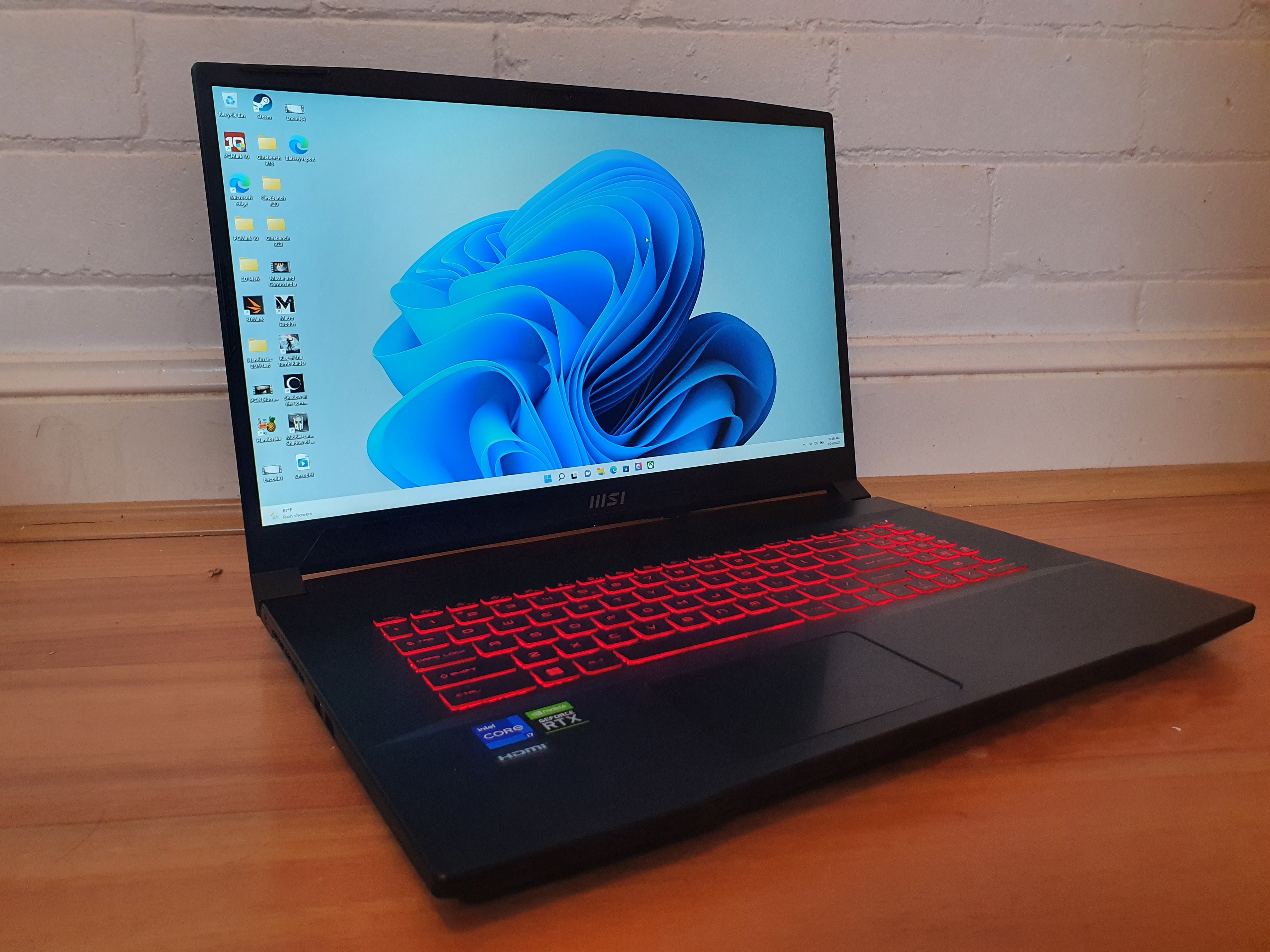
Pros
Decent CPU performance Interesting design with plenty of flair Comfortable keyboard and trackpad
Cons
Lackluster GPU performance The display lacks brightness Audio produces less-than-stellar bass Price When Reviewed:$1,250Best Prices Today:$769.96 at Microcenter$998 at Amazon$1049 at Walmart
If you’re on a tight budget (been there), the MSI GF76 Katana is an excellent value pick. It features an Intel Core i7-12700H CPU, an Nvidia GeForce RTX 3050 Ti GPU, 16GB of RAM, and 512GB of PCle 4 SSD storage. In other words, this laptop is fast enough to handle most photo-editing work as well as everyday use like browsing the web and streaming Netflix. The trackpad and keyboard are surprisingly comfortable, too.
The only real knock against this machine is the dim display. It’s not horrible, but some photo editors may prefer a brighter screen. That said, it’s 17.3-inches and that’s a ton of screen real estate to work with. If you’re a beginner photo editor looking to save some money, the GF76 Katana is well worth considering.
Read our full MSI Katana GF76 review
Asus ROG Strix G18 – Best for power users
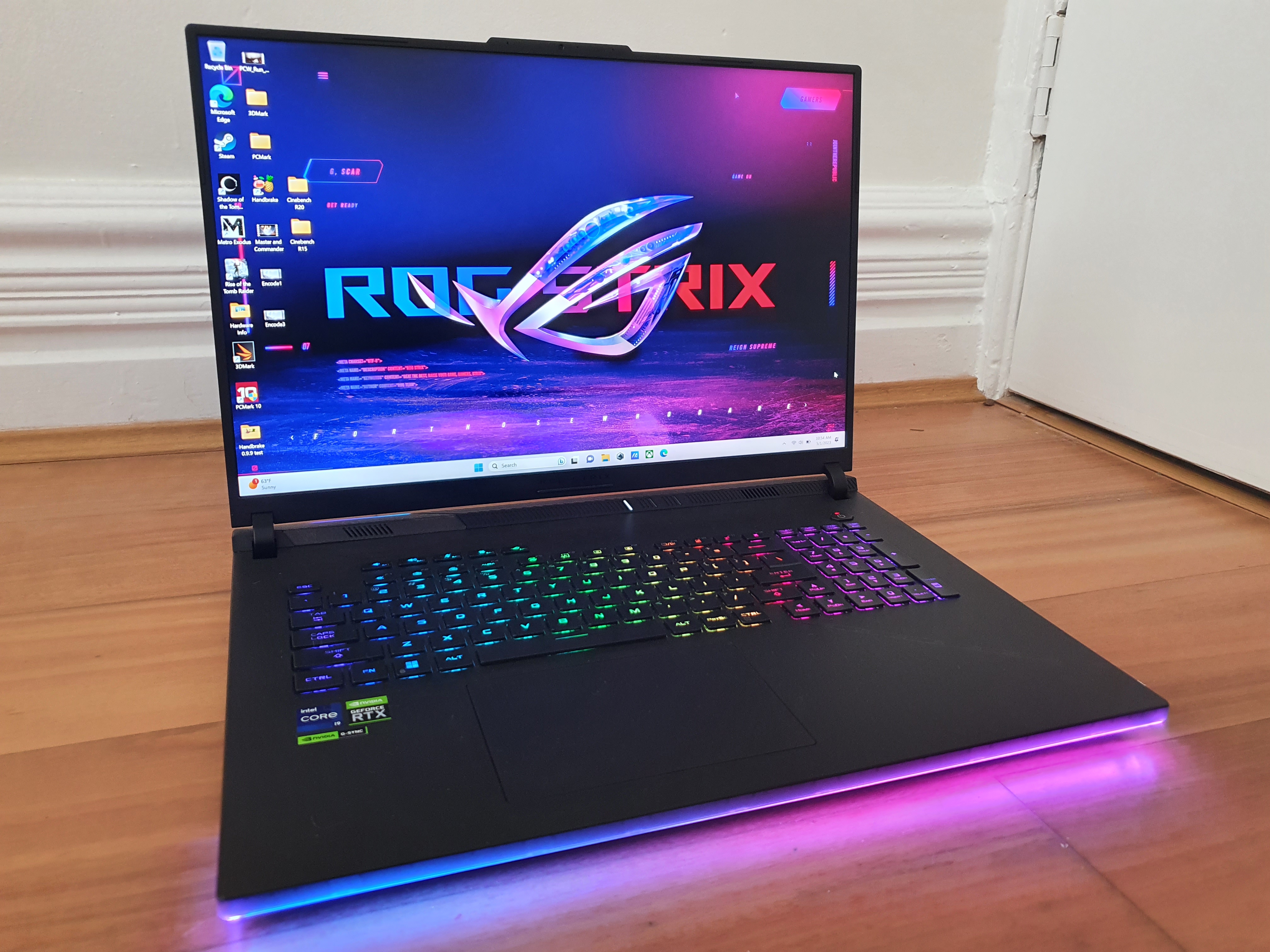
Pros
The CPU and GPU produce impressive power The 18-inch QHD+ display is large and brilliantly colorful Aura Sync RGB light bars lighten things up
Cons
Battery life is just average The trackpad is too firm for all-day use A 1080p webcam would have made it more suitable for creators Price When Reviewed:3899.99Best Prices Today:3899.99 at AsusNot Available at Best Buy
The Asus ROG Strix G18 is a great option for power users because of its Intel Core i9-13980HX CPU and Nvidia GeForce RTX 4090 GPU as well as enhanced airflow and cooling. The G18 passed many of our intensive gaming benchmarks with flying colors. In fact, our reviewer says you can “expect exceptional performance for high-end gaming and for other CPU-intensive tasks like video editing or encoding.” In other words, the G18 is more than capable of handling any photo editing task you throw at it.
By the way, did we mention the enormous 18-inch display? It features a resolution of 2560×1600, an aspect ratio of 16:10 (taller screens are ideal for scrolling through documents and such), and a blazing-fast refresh rate of 240Hz. Visuals should be straight-up lovely, which is important when you’re editing an image. So long as you’re working with a flexible budget, the Asus ROG Strix G18 is worth considering.
Read our full Asus ROG Strix 18 review
Asus Zenbook S 13 OLED – Most portable
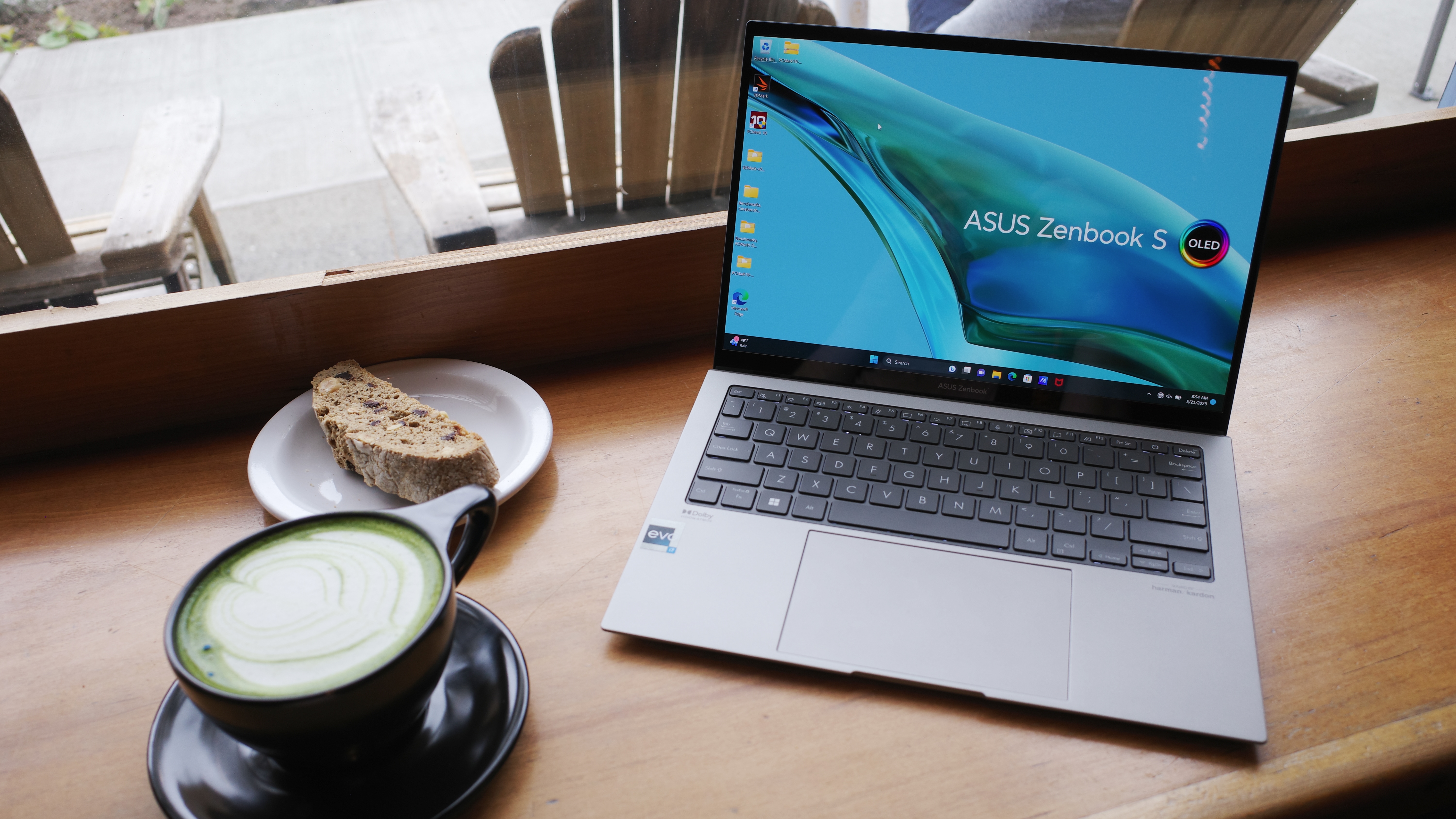
Pros
High-quality build Gorgeous screen Excellent battery life Diverse port selection Competitive performance
Cons
Obnoxious bloatware High-pitched fans Physical trackpad button instead of a linear motor Price When Reviewed:$1,399Best Prices Today:$1199.99 at Best Buy$1349.99 at Walmart$1399.99 at Asus
The Asus Zenbook S 13 OLED is so thin and lightweight, our reviewer first believed the laptop was fake when he took it out of the box. It (barely) tips the scales at just 2.2 pounds, which makes it the perfect traveling companion. The build is surprisingly rugged, especially given the slim profile. Although we love how remarkably featherlight it is, the display is a real standout as well.
The Zenbook S features a 13-inch OLED display with a resolution of 2880×1800, an aspect ratio of 16:10, and a maximum brightness of 550 nits. According to our reviewer, the display produces “gorgeous colors and incredibly dark blacks,” which is vital when you’re doing photo editing work. So, if you’re in the market for a portable laptop with a stunning OLED display, you should definitely check out the Zenbook S 13.
Read our full Asus Zenbook S 13 OLED (2023) review
Dell Inspiron 16 – Best battery life

Pros
Roomy 16-inch 16:10 display Long battery life Competitive application performance Comfortable keyboard and huge touchpad Quad speakers pump up the jams
Cons
Lone GPU upgrade is lackluster Can’t go bigger than 512GB SSD Large screen can feel awkward in tablet mode Price When Reviewed:$1,249.99Best Prices Today:$899.99 at Best Buy
Battery life is an often overlooked feature when searching for the best photo editing laptop. When you’re on the road or out of the office, you need a laptop that will last without charging as long as possible. When we ran our battery benchmark, which cycles through a series of tasks and videos until the laptop dies, the Dell Inspiron 16 lasted a marathon 16.5 hours on a single charge. That should allow you to edit to your heart’s content without worrying about a dead battery. However due to that same battery, it isn’t the most portable, weighing a hefty 4.7 pounds.
It’s rather inexpensive, as well, but sacrifices are made for the price. Under the hood you get an Intel Core i7-1260P CPU, Intel Iris Xe graphics, 16GB of RAM, and 512GB of SSD storage. While that should suffice for most photo editing jobs, the lack of storage capacity means you will likely need an external drive to save all of your high-res photos.
As a bonus perk, the laptop also comes with a surprisingly robust quad speaker system so you can jam out while editing. For ports, you’re getting two USB Type-C, one USB-A 3.2 Gen 1, 1 HDMI, one SD card reader, and one 3.5mm audio jack.
Read our full Dell Inspiron 16 2-in-1 review
Asus ROG Flow Z13 GZ301 – Best folio-style option
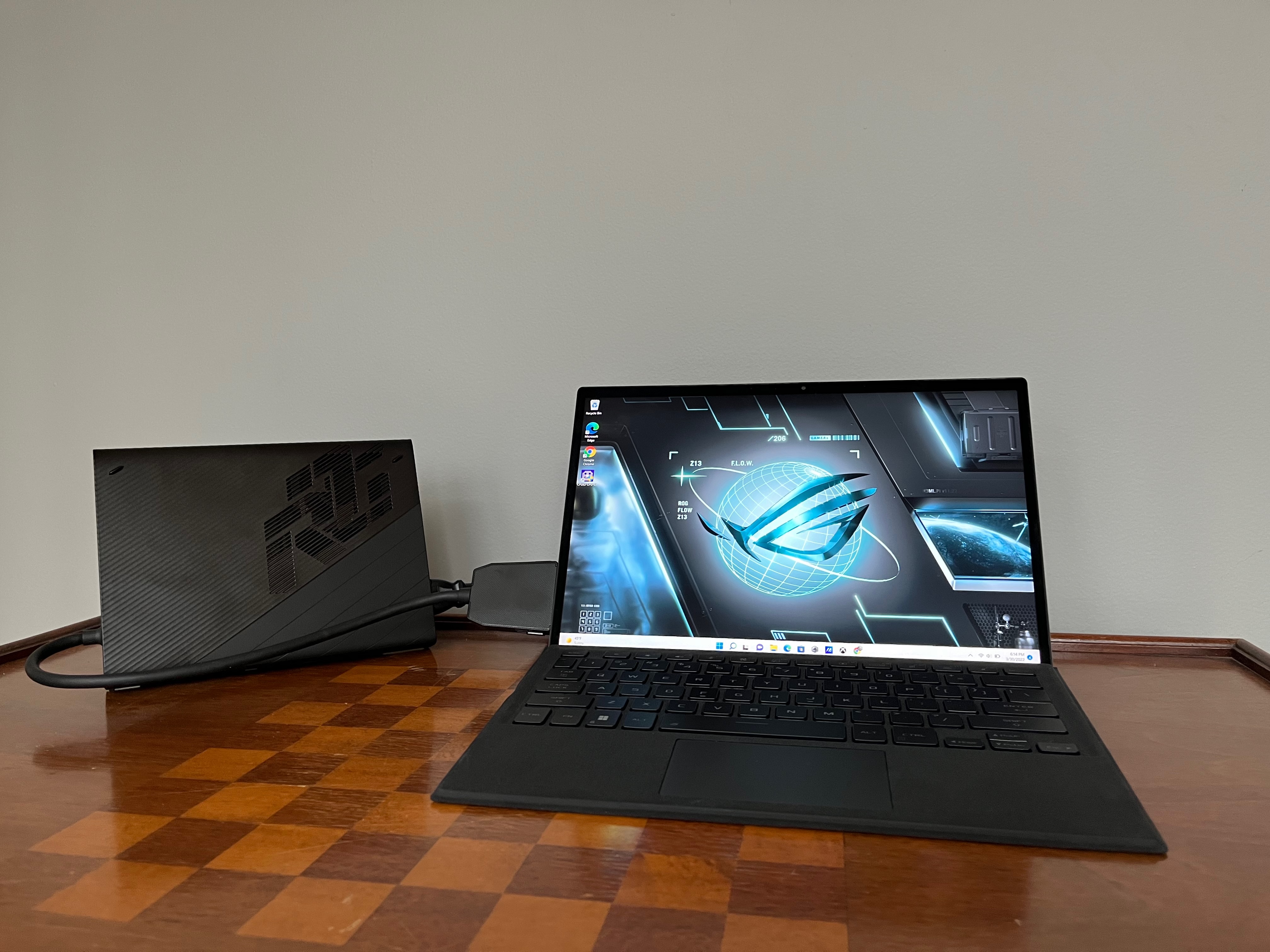
Pros
Big performance in a small package Bright, crisp display Compatible with XG Mobile for GPU boost
Cons
Versatility doesn’t come cheap Detachable keyboard poor fit for gamers Price When Reviewed:$1,899.99Best Prices Today:$1339.99 at Walmart
The Asus ROG Flow Z13 is one of the more unique picks in this roundup. It’s marketed as a folio-style gaming machine. You can pop open the kickstand on the rear plate and use it like a traditional clamshell. You can even remove the keyboard and use it as a touch-enabled tablet. The versatility of this machine makes it a cool choice for creative work. It has some pretty powerful internals, too.
The Flow is rocking an Intel Core i9-12900H CPU, an Nvidia GeForce RTX 3050 Ti GPU, 16GB of RAM, and 512GB of PCIe NVMe M.2 SSD storage. That’s plenty powerful for editing photos and general-use tasks like checking email and browsing the world wide web. The 1200p IPS touch display is also sharp and colorful. The Flow isn’t a budget-friendly option, though. This kind of versatility and power comes at a big price. However, if you’re able to comfortably stretch your budget, the Flow Z13 is a neat choice.
Read our full Asus ROG Flow Z13 GZ301 review
Asus Zenbook Pro 14 Duo OLED – Best dual display
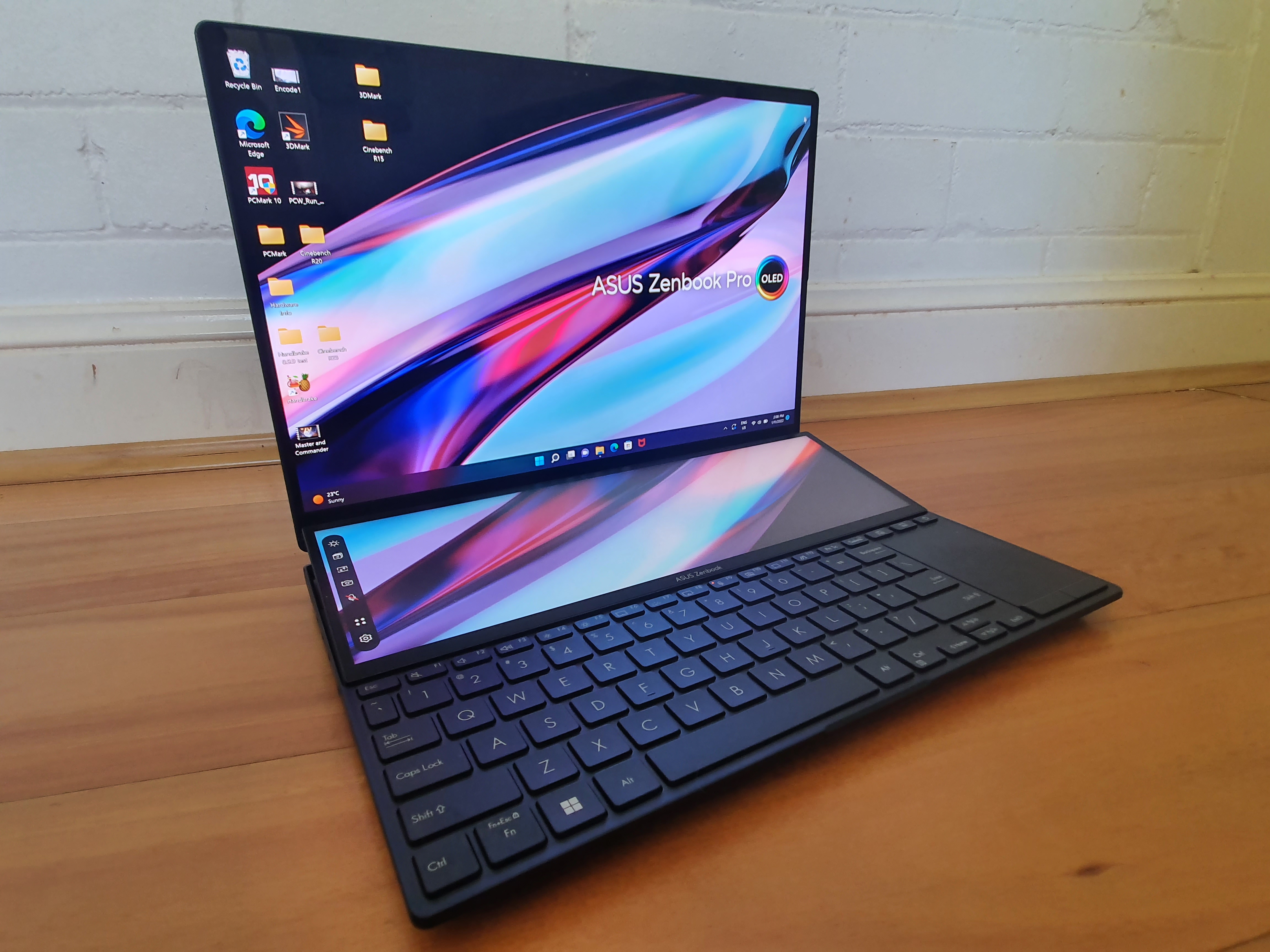
Pros
Stunning primary display and easy to see secondary display Excellent I/O options and wireless connectivity CPU / GPU power meets the needs of content creators
Cons
The battery life is lacking for a productivity laptop The trackpad is small and awkwardly placed Rear orientated ports can be hard to reach Price When Reviewed:$2,000
In need of a dual-display setup but also need it to be portable? You need look no further than the Asus Zenbook Pro 14. It packs solid performance, including a Core i7 processor, GeForce RTX 3050 graphics, 16GB of DDR5 memory, and a zippy 1TB NVMe SSD. It also has a 14.5-inch 4K touch OLED panel that outputs an ultra-bright 547 nits while covering 100 percent of the DCI-P3 color gamut. It’s a main display worthy of the most serious content creators. But the truly unique feature is the secondary 12.7-inch 2880×864 screen located just above the keyboard. Since Windows counts it as a second monitor you are free to use it as a trackpad or to display a panel of touch controls for certain Adobe apps or any other helpful tool you might need while editing photos.
The Zenbook Pro 14 Duo OLED has a lot of power, but the battery life leaves a little to be desired, so you may need to carry around a charging cable if you plan to do serious work on the go. Despite this, the Zenbook Pro 14 Duo OLED is a great option for photo editors or any other content creator and the latest version of Asus’ dual screen is the best yet.
Read our full Asus Zenbook Pro 14 Duo OLED review
Lenovo Slim Pro 7 – Best Lenovo laptop for photo editing

Pros
Attractive, slim design Excellent keyboard and touchpad Strong CPU and GPU performance Respectable battery life
Cons
Mediocre display No SDcard reader Price When Reviewed:$1,199.99Best Prices Today:1199.99 at Best Buy
The Lenovo Slim Pro 7 is a solid laptop for most photo editors, as it really gets the fundamentals right. It offers reliable CPU and GPU performance, decent battery life, and a superb keyboard and trackpad. Inside, you’ll find an AMD Ryzen 7735HS CPU, an Nvidia RTX 3050 GPU, 16GB of RAM, and 512GB of SSD storage. That’s more than enough power for day-to-day tasks as well as photo editing. Overall, this laptop is a good all-arounder. It’s versatile, affordable (it’s on sale for $1,199.99 at Best Buy as of this writing), and relatively lightweight at 3.5 pounds. What more could you ask for?
Read our full Lenovo Slim Pro 7 review
Samsung Galaxy Book3 Ultra – Best Samsung laptop for photo editing
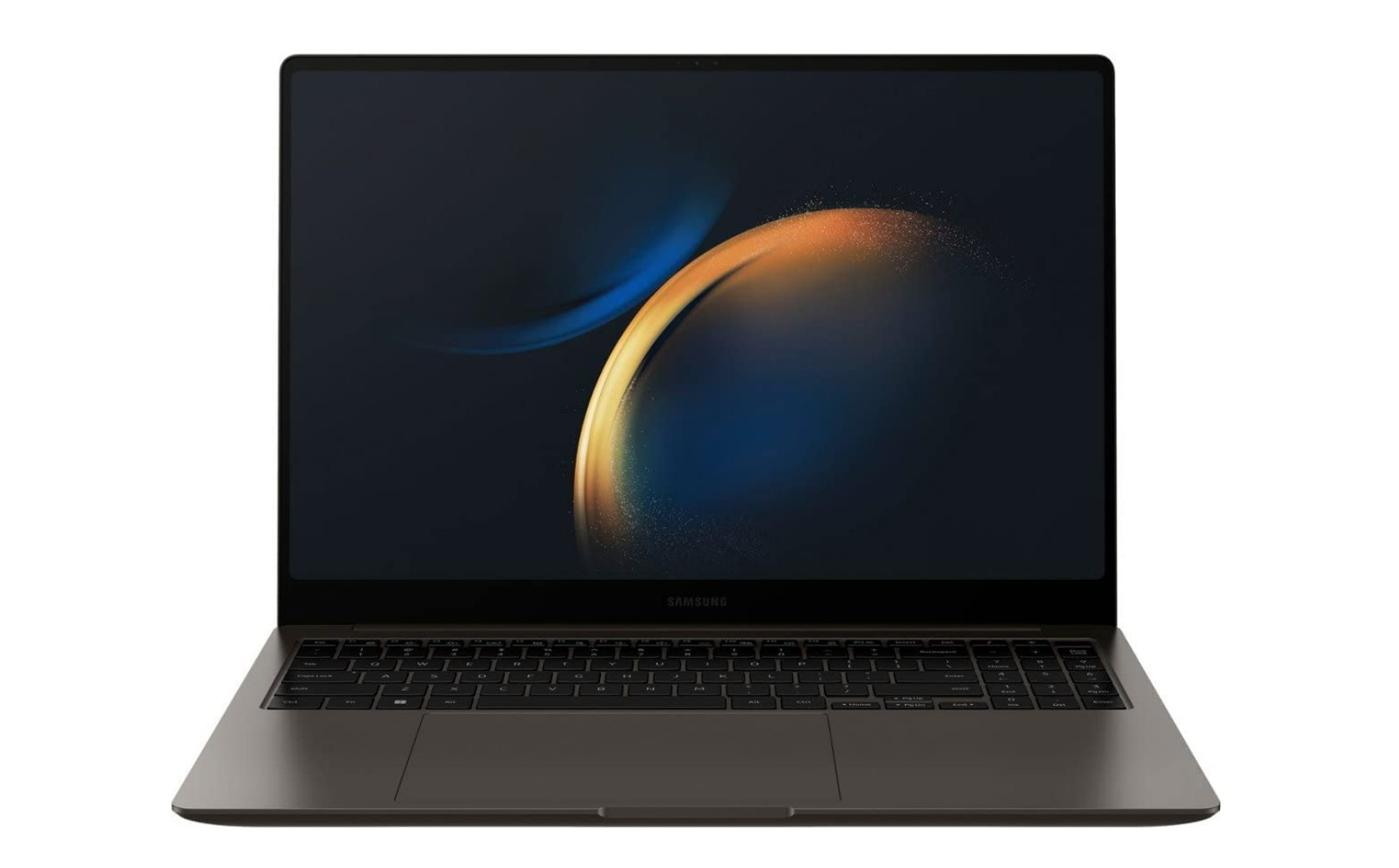
Pros
Solid performance and great battery life Gorgeous, powerful OLED screen A 1080p webcam with Windows Studio Effects Good interaction with Galaxy device ecosystem and apps
Cons
Average keyboard, trackpad Audio needs some tweaking Price When Reviewed:From $2,099.99Best Prices Today:$1,554.99 at Amazon$1679.99 at Best Buy$2399.99 at Samsung
The Samsung Galaxy Book3 Ultra has a lot to offer as far as content creation laptops go. You’re getting a gorgeous OLED display, solid battery life, and strong performance. It’s packing an Intel Core i7-13700H CPU and an Nvidia GeForce RTX 4050 GPU. That combination right there means the laptop should be able to chew through most resource-heavy tasks. The 16-inch AMOLED display also has a resolution of 2880×1800, a refresh rate of 120Hz, and a maximum brightness of 400 nits. The display should deliver nothing but vibrant, buttery-smooth visuals.
Read our full Samsung Galaxy Book3 Ultra review
Apple 16-inch MacBook Pro (2023) – Best MacBook for photo editing

Pros
Good performance boost over its predecessor HDMI upgrade expands external display options Equipped with Wi-Fi 6E and Bluetooth 5.3
Cons
1080p camera without Center Stage Some will deem the notch unsightly Touch Bar fans will be disappointed No ethernet port Price When Reviewed:$3,499Best Prices Today:$2,999.95 at Amazon$3079.99 at Adorama$3148.95 at B&H
If you’re married to the Apple ecosystem, you better listen up. The Apple MacBook Pro 2023 is an excellent choice for photo editors because it has a great deal of graphics firepower as well as a ton of storage space. The GPU has 19 cores, and the 2TB of SSD storage is perfect for offloading images. The 16.2-inch Liquid Retina XDR display is also quite stunning, with a maximum brightness of over 1,000 nits and a resolution of 3456×2234. If you’re on the hunt for a killer laptop with loads of power, the Apple MacBook Pro 2023 is the one to pick.
Read our full Apple MacBook Pro 2023 review
How we tested
The PCWorld team puts each and every Windows laptop through a series of benchmarks that test GPU and CPU performance, battery life, and so on. The idea is to push the laptop to its limits and then compare it against others we’ve tested. Below, you’ll find a breakdown of each test and the reasons why we run them.
Windows laptops
PCMark 10: PCMark 10 is how we determine how well the laptop handles general use tasks like web browsing, word processing, spreadsheets, and so on. It’s how we simulate everyday use in a specific time frame.HandBrake: HandBrake is more intensive than PCMark 10. It measures how long a laptop’s CPU takes to encode a beefy 30GB file. This is more like a stress test.Cinebench: Cinebench is a brief stress test of the CPU cores. It does this by rendering a 2D scene over a short period of time. This benchmark shows us how well the CPU splits the workload.3DMark: 3DMark checks if 3D performance remains consistent over time by running graphic-intensive clips. These benchmarks are used on gaming laptops.Video rundown test: To gauge battery life, we loop a 4K video using Windows 10’s Movies & TV app until the laptop dies. If you’re a regular traveler, you’ll want a battery that can last longer than a full work day.
FAQ
1.
How much processing power will I need?
For most photo editing work, an Intel Core i5 or i7 processor is fine. Need more oomph? Go for an Intel Core i9. The most important thing is the number of cores. The more cores, the better your CPU can divide the workload. For AMD options, the Ryzen 5 series is zippy enough for basic photo editing work. If you need faster response times, shoot for a Ryzen 9.
2.
Do I need a discrete graphics card?
It’s not absolutely necessary, but it will make a difference when using photo editing applications. If you want super-fast performance, go with a laptop with that has a dedicated graphics card. For those on a strict budget, go for an Nvidia RTX 3060 or 3050 Ti. For a serious boost in graphics performance, aim for an Nvidia RTX 3080 Ti or a AMD Radeon RX6800S.
3.
How much memory is enough?
RAM will keep your laptop running nice and smooth as you edit those darling baby photos. We’d recommend 8GB of RAM as the minimum. For bigger projects, go for 16GB.
4.
Should I spring for a hard disk drive or an SSD?
RAW image files are massive, so you’re going to need a high-capacity SSD, as solid-state drives are faster and quieter than hard disk drives. 256GB is the minimum amount we’d recommend, but more is obviously better. For really big projects, go for 512GB or 1TB.
5.
Does screen quality matter?
We’d argue that screen quality is one of the most important aspects of a laptop, especially for photo editing work. Don’t settle for anything less than 1080p resolution. That’s your baseline. If you can spend a little more, 4K is best for detailed creative work and OLED tends to be more color accurate.
6.
Is portability important for a photo editing laptop?
Do you often take your work to a coffee shop? If so, you’ll want a laptop with a 13- or 14-inch display, as it’s smaller and more portable. Anything that weighs around three pounds or less is considered an ultraportable. That’s the golden number you want to hit.
7.
How long should my laptop last on a single charge?
If you plan on taking your laptop everywhere with you, 10 to 12 hours on a single charge is the sweet spot. That’s more than a full work day. However, know that battery size impacts the portability of the machine. The bigger the battery, the heavier the laptop.



